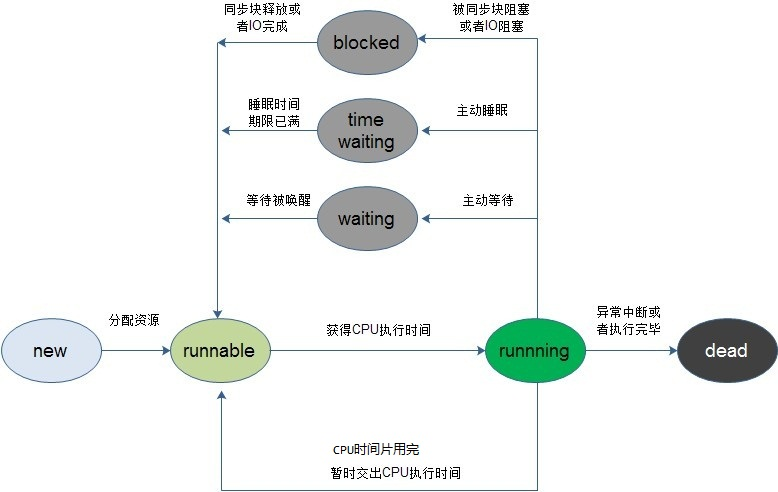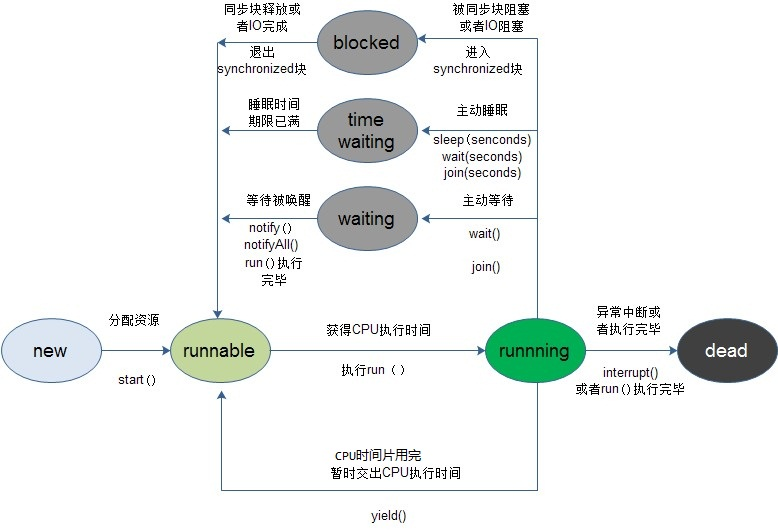Java並發編程:Thread類的使用
一.線程的狀態
在正式學習Thread類中的具體方法之前,我們先來了解一下線程有哪些狀態,這個將會有助於後面對Thread類中的方法的理解。
線程從創建到最終的消亡,要經歷若幹個狀態。一般來說,線程包括以下這幾個狀態:創建(new)、就緒(runnable)、運行(running)、阻塞(blocked)、time waiting、waiting、消亡(dead)。
public enum State {
/**
* Thread state for a thread which has not yet started.
*/
NEW,
/**
當需要新起一個線程來執行某個子任務時,就創建了一個線程。但是線程創建之後,不會立即進入就緒狀態,因為線程的運行需要一些條件(比如內存資源,在前面的JVM內存區域劃分一篇博文中知道程序計數器、Java棧、本地方法棧都是線程私有的,所以需要為線程分配一定的內存空間),只有線程運行需要的所有條件滿足了,才進入就緒狀態。
當線程進入就緒狀態後,不代表立刻就能獲取CPU執行時間,也許此時CPU正在執行其他的事情,因此它要等待。當得到CPU執行時間之後,線程便真正進入運行狀態。
線程在運行狀態過程中,可能有多個原因導致當前線程不繼續運行下去,比如用戶主動讓線程睡眠(睡眠一定的時間之後再重新執行)、用戶主動讓線程等待,或者被同步塊阻塞,此時就對應著多個狀態:time waiting(睡眠或等待一定的時間)、waiting(等待被喚醒)、blocked(阻塞)。
當由於突然中斷(拋異常)或者子任務執行完畢,線程就會被消亡。
下面這副圖描述了線程從創建到消亡之間的狀態:

在有些教程上將blocked、waiting、time waiting統稱為阻塞狀態,這個也是可以的,只不過這裏我想將線程的狀態和Java中的方法調用聯系起來,所以將waiting和time waiting兩個狀態分離出來。
二.上下文切換
對於單核CPU來說(對於多核CPU,此處就理解為一個核),CPU在一個時刻只能運行一個線程,當在運行一個線程的過程中轉去運行另外一個線程,這個叫做線程上下文切換(對於進程也是類似)。
由於可能當前線程的任務並沒有執行完畢,所以在切換時需要保存當前線程的運行狀態,以便下次重新切換回來時能夠繼續切換之前的狀態運行。舉個簡單的例子:比如一個線程A正在讀取一個文件的內容,正讀到文件的一半,此時需要暫停線程A,轉去執行線程B,當再次切換回來執行線程A的時候,我們不希望線程A又從文件的開頭來讀取,我們希望從上次暫停的地方開始繼續讀取,這就需要知道上次暫停的位置。
因此需要記錄線程A的運行狀態,那麽會記錄哪些數據呢?因為下次恢復時需要知道在這之前當前線程已經執行到哪條指令了,所以需要記錄程序計數器的值,另外比如說線程正在進行某個計算的時候被掛起了,那麽下次繼續執行的時候需要知道之前掛起時變量的值時多少,因此需要記錄CPU寄存器的狀態。所以一般來說,線程上下文切換過程中會記錄程序計數器、CPU寄存器狀態等數據。
說簡單點的:對於線程的上下文切換實際上就是 存儲和恢復CPU狀態的過程,它使得線程執行能夠從中斷點恢復執行。
雖然多線程可以使得任務執行的效率得到提升,但是由於在線程切換時同樣會帶來一定的開銷代價,並且多個線程會導致系統資源占用的增加,所以在進行多線程編程時要註意這些因素。
三.Thread類中的方法
通過查看java.lang.Thread類的源碼可知:
public class Thread implements Runnable {
/* Make sure registerNatives is the first thing <clinit> does. */
private static native void registerNatives();
static {
registerNatives();
}
private volatile String name;
private int priority;
private Thread threadQ;
private long eetop;
/* Whether or not to single_step this thread. */
private boolean single_step;
/* Whether or not the thread is a daemon thread. */
private boolean daemon = false;
/* JVM state */
private boolean stillborn = false;
/* What will be run. */
private Runnable target;
/* The group of this thread */
private ThreadGroup group;
/* The context ClassLoader for this thread */
private ClassLoader contextClassLoader;
/* The inherited AccessControlContext of this thread */
private AccessControlContext inheritedAccessControlContext;
/* For autonumbering anonymous threads. */
private static int threadInitNumber;
private static synchronized int nextThreadNum() {
return threadInitNumber++;
}
/* ThreadLocal values pertaining to this thread. This map is maintained
* by the ThreadLocal class. */
ThreadLocal.ThreadLocalMap threadLocals = null;
}
Thread類實現了Runnable接口,在Thread類中,有一些比較關鍵的屬性,比如name是表示Thread的名字,可以通過Thread類的構造器中的參數來指定線程名字,priority表示線程的優先級(最大值為10,最小值為1,默認值為5),daemon表示線程是否是守護線程,target表示要執行的任務。
下面是Thread類中常用的方法:
以下是關系到線程運行狀態的幾個方法:
1)start方法
start()用來啟動一個線程,當調用start()方法後,系統才會開啟一個新的線程來執行用戶定義的子任務,在這個過程中,會為相應的線程分配需要的資源。
2)run方法
run()方法是不需要用戶來調用的,當通過start方法啟動一個線程之後,當線程獲得了CPU執行時間,便進入run方法體去執行具體的任務。註意,繼承Thread類必須重寫run方法,在run方法中定義具體要執行的任務。
3)sleep方法
sleep方法有兩個重載版本:
sleep(long millis) //參數為毫秒
sleep(long millis,int nanoseconds) //第一參數為毫秒,第二個參數為納秒
sleep相當於讓線程睡眠,交出CPU,讓CPU去執行其他的任務。
但是有一點要非常註意,sleep方法不會釋放鎖,也就是說如果當前線程持有對某個對象的鎖,則即使調用sleep方法,其他線程也無法訪問這個對象。看下面這個例子就清楚了:
public class Test {
private int i = 10;
private Object object = new Object();
public static void main(String[] args) throws IOException {
Test test = new Test();
MyThread thread1 = test.new MyThread();
MyThread thread2 = test.new MyThread();
thread1.start();
thread2.start();
}
class MyThread extends Thread {
@Override
public void run() {
synchronized (object) {
i++;
System.out.println("i:" + i);
try {
System.out.println("線程" + Thread.currentThread().getName() + "進入睡眠狀態");
Thread.currentThread().sleep(10000);
} catch (InterruptedException e) {
// TODO: handle exception
}
System.out.println("線程" + Thread.currentThread().getName() + "睡眠結束");
i++;
System.out.println("i:" + i);
}
}
}
}
輸出結果:
i:11
線程Thread-0進入睡眠狀態
線程Thread-0睡眠結束
i:12
i:13
線程Thread-1進入睡眠狀態
線程Thread-1睡眠結束
i:14
從上面輸出結果可以看出,當Thread-0進入睡眠狀態之後,Thread-1並沒有去執行具體的任務。只有當Thread-0執行完之後,此時Thread-0釋放了對象鎖,Thread-1才開始執行。
註意,如果調用了sleep方法,必須捕獲InterruptedException異常或者將該異常向上層拋出。當線程睡眠時間滿後,不一定會立即得到執行,因為此時可能CPU正在執行其他的任務。所以說調用sleep方法相當於讓線程進入阻塞狀態。
4)yield方法
調用yield方法會讓當前線程交出CPU權限,讓CPU去執行其他的線程。它跟sleep方法類似,同樣不會釋放鎖。但是yield不能控制具體的交出CPU的時間,另外,yield方法只能讓擁有相同優先級的線程有獲取CPU執行時間的機會。
註意,調用yield方法並不會讓線程進入阻塞狀態,而是讓線程重回就緒狀態,它只需要等待重新獲取CPU執行時間,這一點是和sleep方法不一樣的。
5)join方法
join方法有三個重載版本:
join()
join(long millis) //參數為毫秒
join(long millis,int nanoseconds) //第一參數為毫秒,第二個參數為納秒
假如在main線程中,調用thread.join方法,則main方法會等待thread線程執行完畢或者等待一定的時間。如果調用的是無參join方法,則等待thread執行完畢,如果調用的是指定了時間參數的join方法,則等待一定的時間。
看下面一個例子:
import java.io.IOException;
public class Test {
public static void main(String[] args) throws IOException {
System.out.println("進入線程:"+Thread.currentThread().getName());
Test test = new Test();
MyThread thread1 = test.new MyThread();
thread1.start();
try {
System.out.println("線程"+Thread.currentThread().getName()+"等待");
thread1.join();
System.out.println("線程"+Thread.currentThread().getName()+"繼續執行");
} catch (InterruptedException e) {
// TODO Auto-generated catch block
e.printStackTrace();
}
}
class MyThread extends Thread{
@Override
public void run() {
System.out.println("進入線程:"+Thread.currentThread().getName());
try {
Thread.currentThread().sleep(5000);
} catch (InterruptedException e) {
// TODO: handle exception
}
System.out.println("線程"+Thread.currentThread().getName()+"執行完畢");
}
}
}
輸出結果:
進入線程main
線程main等待
進入線程Thread-0
線程Thread-0執行完畢
線程main繼續執行
可以看出,當調用thread1.join()方法後,main線程會進入等待,然後等待thread1執行完之後再繼續執行。
實際上調用join方法是調用了Object的wait方法,這個可以通過查看源碼得知:
public final synchronized void join(long millis)
throws InterruptedException {
long base = System.currentTimeMillis();
long now = 0;
if (millis < 0) {
throw new IllegalArgumentException("timeout value is negative");
}
if (millis == 0) {
while (isAlive()) {
wait(0);
}
} else {
while (isAlive()) {
long delay = millis - now;
if (delay <= 0) {
break;
}
wait(delay);
now = System.currentTimeMillis() - base;
}
}
}
wait方法會讓線程進入阻塞狀態,並且會釋放線程占有的鎖,並交出CPU執行權限。
由於wait方法會讓線程釋放對象鎖,所以join方法同樣會讓線程釋放對一個對象持有的鎖。具體的wait方法使用在後面文章中給出。
6)interrupt方法
interrupt,顧名思義,即中斷的意思。單獨調用interrupt方法可以使得處於阻塞狀態的線程拋出一個異常,也就說,它可以用來中斷一個正處於阻塞狀態的線程;另外,通過interrupt方法和isInterrupted()方法來停止正在運行的線程。
下面看一個例子:
import java.io.IOException;
public class Test {
public static void main(String[] args) throws IOException {
Test test = new Test();
MyThread thread = test.new MyThread();
thread.start();
try {
Thread.currentThread().sleep(2000);
} catch (InterruptedException e) {
}
thread.interrupt();
}
class MyThread extends Thread {
@Override
public void run() {
try {
System.out.println("進入睡眠狀態");
Thread.currentThread().sleep(10000);
System.out.println("睡眠完畢");
} catch (InterruptedException e) {
System.out.println("得到中斷異常");
}
System.out.println("run方法執行完畢");
}
}
}
輸出結果:
進入睡眠狀態
得到中斷異常
run方法執行完畢
從這裏可以看出,通過interrupt方法可以中斷處於阻塞狀態的線程。那麽能不能中斷處於非阻塞狀態的線程呢?看下面這個例子:
public class Test {
public static void main(String[] args) throws IOException {
Test test = new Test();
MyThread thread = test.new MyThread();
thread.start();
try {
Thread.currentThread().sleep(2000);
} catch (InterruptedException e) {
}
thread.interrupt();
}
class MyThread extends Thread{
@Override
public void run() {
int i = 0;
while(i<Integer.MAX_VALUE){
System.out.println(i+" while循環");
i++;
}
}
}
}
運行該程序會發現,while循環會一直運行直到變量i的值超出Integer.MAX_VALUE。所以說直接調用interrupt方法不能中斷正在運行中的線程。
但是如果配合isInterrupted()能夠中斷正在運行的線程,因為調用interrupt方法相當於將中斷標誌位置為true,那麽可以通過調用isInterrupted()判斷中斷標誌是否被置位來中斷線程的執行。比如下面這段代碼:
public class Test {
public static void main(String[] args) throws IOException {
Test test = new Test();
MyThread thread = test.new MyThread();
thread.start();
try {
Thread.currentThread().sleep(2000);
} catch (InterruptedException e) {
}
thread.interrupt();
}
class MyThread extends Thread{
@Override
public void run() {
int i = 0;
while(!isInterrupted() && i<Integer.MAX_VALUE){
System.out.println(i+" while循環");
i++;
}
}
}
}
運行會發現,打印若幹個值之後,while循環就停止打印了。
但是一般情況下不建議通過這種方式來中斷線程,一般會在MyThread類中增加一個屬性 isStop來標誌是否結束while循環,然後再在while循環中判斷isStop的值
class MyThread extends Thread{
private volatile boolean isStop = false;
@Override
public void run() {
int i = 0;
while(!isStop){
i++;
}
}
public void setStop(boolean stop){
this.isStop = stop;
}
}
那麽就可以在外面通過調用setStop方法來終止while循環。
7)stop方法
stop方法已經是一個廢棄的方法,它是一個不安全的方法。因為調用stop方法會直接終止run方法的調用,並且會拋出一個ThreadDeath錯誤,如果線程持有某個對象鎖的話,會完全釋放鎖,導致對象狀態不一致。所以stop方法基本是不會被用到的。
8)destroy方法
destroy方法也是廢棄的方法。基本不會被使用到。
以下是關系到線程屬性的幾個方法:
1)getId
用來得到線程ID
2)getName和setName
用來得到或者設置線程名稱。
3)getPriority和setPriority
用來獲取和設置線程優先級。
4)setDaemon和isDaemon
用來設置線程是否成為守護線程和判斷線程是否是守護線程。
守護線程和用戶線程的區別在於:守護線程依賴於創建它的線程,而用戶線程則不依賴。舉個簡單的例子:如果在main線程中創建了一個守護線程,當main方法運行完畢之後,守護線程也會隨著消亡。而用戶線程則不會,用戶線程會一直運行直到其運行完畢。在JVM中,像垃圾收集器線程就是守護線程。
Thread類有一個比較常用的靜態方法currentThread()用來獲取當前線程。
在上面已經說到了Thread類中的大部分方法,那麽Thread類中的方法調用到底會引起線程狀態發生怎樣的變化呢?下面一幅圖就是在上面的圖上進行改進而來的:

參考:
http://www.cnblogs.com/dolphin0520/p/3920357.html
Java並發編程:Thread類的使用
